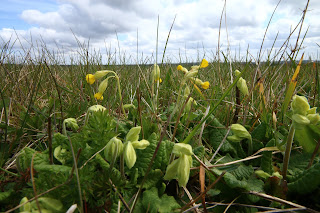I think orchids are just the best!
I went over to Westwell Gorse this morning and as expected Early purple orchids (
Orchis mascula) were at last just coming into flower. One of the earliest orchids to emerge, records have been posted on Facebook of plants in flower starting on the Isle of White on 13 April, then Kent and Sussex, South Wales and so on. At Westwell there are at least 50 plants at a guess, all on a dryish area on the edge of scrub, rather than in a more wooded area nearby.
The plant is widespread throughout the UK; Stace suggests a preference for neutral to basic soils, out in the open up north, more shaded down south, more common in ancient woodland, so the Westwell situation is a little surprising. Elsewhere in Oxfordshire I have seen plants at Foxholes in damp woodland whereas on Skye it was not uncommon to find it on ungrazed basalt ledges on mountain slopes, buffeted by winds, or on the limestone pavement of Ben Suardal in the south of the island. It is though hard to see a pattern in the distribution and be able to predict where it might occur.
It has virtually no hybrids with other UK orchids. It is commonest member of the Orchis genus in the UK. There is a distributional overlap, but Stace et al in their Hybrid Flora of the British Isles give only one record for the hybrid with the Green-winged orchid, Anacamptis morio (recently reclassified from Orchis morio), and there seems to be no hybrid with Man orchid. Given the libertine nature of several orchid genera this seems surprising.
I found this orchid just about the easiest to recognise from just the leaves. It has a definite rosette - some of the smaller plants I looked at this morning had as few as 4 leaves all at right angles, but more robust plants had more basal leaves, essentially in a two tiered rosette, radiating out as if the spokes of a wheel. Stem leaves are sheathing. The leaf spots are larger and more blotchy than those of Common spotted orchids; the leaf edge is described by Poland and Clement as crenulate.























































